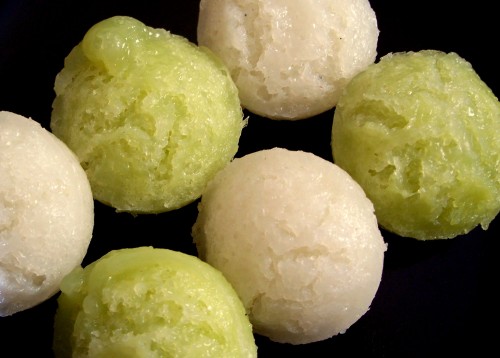 Does this happen to you often? You give a friend something to taste, he says “It’s good. What’s it called?”. You’re stumped. The English translation is easy, but it would make no sense because the name matches neither the food, the ingredients, nor the method of cooking. It happens to me quite often, and usually I shut off the questions with “Just eat it!”. But I wonder, too. Southern Vietnamese folks have a niche for obscure naming scheme. The names could have sprouted from some jokes, some overly simplified impromptu description they thought of at the moment, some mispronounced foreign names, who knows. The result is intelligible and untranslatable, like bánh khọt, bánh tét, chả đùm. The translatable-but-not-always-understandable cases happen when they attach random verbs after the categorical nouns to make a new name, like bánh xèo – “sizzling banh”, bánh lọt – “falling-through banh”, bò né – “dodging beef”, whatever that’s supposed to mean. Bánh bò belongs to this flock. Cow bánh? Unlikely, the thing is vegan to an n. I even thought about the possibility that the name is derived from its resemblance of the cow’s tripe, but they would have called it tripe […]
Continue reading Sandwich Shop Goodies 9 – Bánh bò bông (Steamed sponge muffin)
 Yet another sticky rice snack that I vaguely remember eating one or twice during the early childhood, and found again in a San Jose sandwich shop more than ten years later. I was excited when I saw these green balls covered in coconut bits. We Vietnamese call them bánh bao chỉ to distinguish from the meat-filled steamed bun made from wheat flour known to us as bánh bao. Just as bánh bao comes from China, so does bánh bao chỉ. Just as bánh bao are baozi and mantou in Mandarin, mandu in Korean, manju in Japanese, manti in Turkish, and many more, bánh bao chỉ too has its share of names. The most-result-yielding Google search belongs to loh mai chi, commonly shown as little sticky rice flour dumplings with sweet ground peanut filling. Other variations in Malaysian and Chinese food blogs are snowball, loh mi chi, chi fa bun, muah chee (yeah, these are really cute you’d want to kiss them too)*, noh mi chi, and ma zi. Once again, I feel the need to learn Mandarin. Some say “noh mi” means “sticky rice” in Cantonese, but what does “chi” mean? Others, […]
Continue reading Sandwich Shop Goodies 8 – Bánh bao chỉ (loh mai chi)
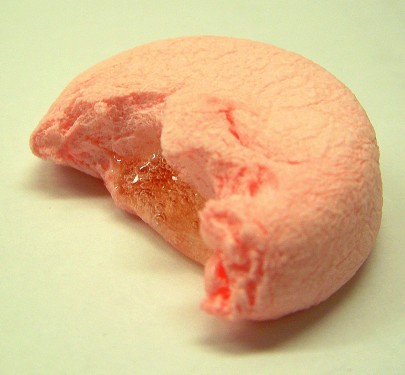 Sometimes, very seldom, I feel the urge to learn Chinese. There are just too many little Chinese things going around without English labels. In fact, the harder it is to describe, the more likely its name is all in Chinese. Take these sweets for instance. They come in handmade red paper boxes at a wedding. This one shapes like a corn ear, smells and tastes like corn, and aptly has an English name: Corn Flavour Jelly. A nice chew but you gotta git it down fast or you git tireduvit. Continue reading Chinese candy talking
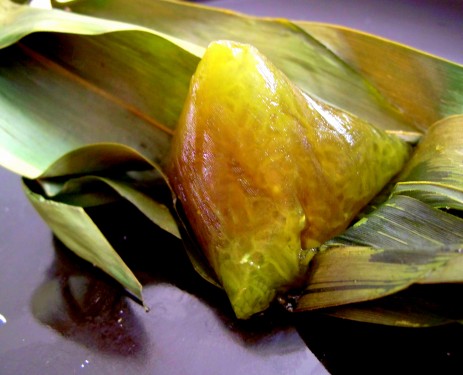 It’s been two weeks, but better late than never. After I read Jessica’s zong zi post on Food Mayhem, images of amber tedrahedra just wouldn’t leave me alone. I talked to my mom about them, and I could hear her voice crackle with sweet memories over the phone. We haven’t had these sweet little things for years. We used to eat them by the dozens every lunar May. Like most Saigonese, we didn’t do anything huge to celebrate Tet Doan Ngo, but bánh ú tro was too scrumptious a tradition to pass. Each pyramid is just a little over an inch tall, whichever way you roll it. It’s unclear whether the traditional zongzi grew smaller when Chinese immigrants share the recipe with their Vietnamese neighbors, or only the dessert zongzi (jianshui zong) is favored by the locals over savory types. Most Vietnamese have also long dissociated this sticky rice snack with the Chinese reason behind Duanwu festival, if not to assign the Fifth of Lunar May to commemorate the death anniversary of Vietnam’s legendary Mother Âu Cơ, kill off bad bugs, make ceremonial offerings to family […]
Continue reading Sandwich shop goodies 3 – Bánh ú tro (Vietnamese-adapted jianshui zong)
 In the middle of bright yellow paste lies a crimson orange ball. The egg yolk. Salted and dried up to the size of a cherry. Or should we say it is the moon, at its fullest on the fifteenth day of the eighth lunar month each year. Roughly 650 years ago, it was a bright moon for the Ming Dynasty, but not so bright for the Yuan Dynasty. The Mongolian rulers’ defeats started from a full moon day of August 1368, when the capital Dadu (present day Beijing) was captured by Zhu Yuanzhang and his Han Chinese insurrection armies. Zhu Yuanzhang then rose to the throne as the first king of the Ming dynasty, and he made sure that the Mid-Autumn Festival, which coincides with the end of the harvesting season, was celebrated throughout the country. As the story goes, such revolutionary victory could not have happened without them little mooncakes. They were secret means of distributing messages among the resisting forces. Words were printed on each mooncake as a simple puzzle. Each mooncake in a package of four was then cut into four pieces, and the sixteen parts were arranged in […]
Continue reading Sandwich Shop Goodies 2 – Bánh bía (Suzhou mooncake)
 I’ll keep it short and sweet: it’s dim sum today. I gave up on microwaving the frozen potstickers that never get cooked in a microwave, and we set out for some steamy bamboo baskets, the real stuff. It was prime lunch time. I was hungry like a grasshopper when we went to New East Lake last weekend, and looking around at the other tables covered with plates didn’t help much. Thank goodness the kitchen didn’t let any cooking smoke escape to the dining area. The wait was of course shorter than it seemed. After I snapped a few pictures around, our first three baskets arrived. Continue reading New East Lake of Milpitas
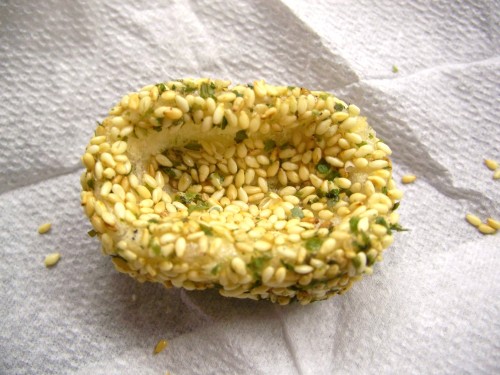 I press my thumbs down, the little egg shape dutifully collapses, but remains in tact, except for a few sesame seeds. I have deformed a perfect fluff ball out of curiosity. As resilient to breaking as it is, it can’t ever re-inflate like our economy. A bit of guilt creeps in. These little fluff balls come from a lengthy process, as indicated by their name (“佬” – lao). Sticky rice flour is mixed with some other rice flour to make the initial dough and let fermented. My guess is fermentation plays a central role in forming the porous structure, when the dough ball gets deep fried. As malt sugar and lard covers their vulnerably hot surface, ’em balls are quickly rolled and tossed in roasted sesame seeds. And there, you get a fresh batch of mi lao, sesame (sticky rice) fluff. (*) Originally, the sesame fluffs were meant to be a part of the Lunar New Year offerings in China, but who wouldn’t welcome a snack like this year round, so different spin-offs roll out of street stalls in Taiwan, like peanut-lao, almond-lao, rice-lao. Tiny bits of dried laver (nori) creatively dimple the […]
Continue reading Sesame fluff – Chinese snack mi lao
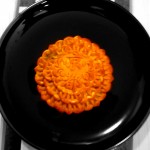 That time of the year has come. Time for the first midterm exam of the undergraduates, and the first exam-grading party of the graduate students. Time for looking back and asking what have I been doing since school started, beside avoiding my advisor for fear of his question “how is the research going?”. Time for kids to buy lanterns, if you’re in Vietnam, and for adults to return home, if you’re in Korea. Time for Walmart, Michael’s, Kroger and the gang to pull out a full display of Halloween and Thanksgiving colors. Time for Asian expats to savour their mooncakes. It isn’t called “mooncake” for no reason. There’s a moon inside the cake. A bright deep yellow egg yolk, salted to perfection. I always eat this last, putting the whole ball in my mouth and slowly eroding it away. The background of the “moon” can be anything, from assorted nuts and lap cheong to sweetened bean paste. Kinh Do churned out the green tea version (nonexistent in Saigon when I was there 5 years ago). Talk about 2-in-1 convenience, now you […]
Continue reading Mid autumn and the moon cake
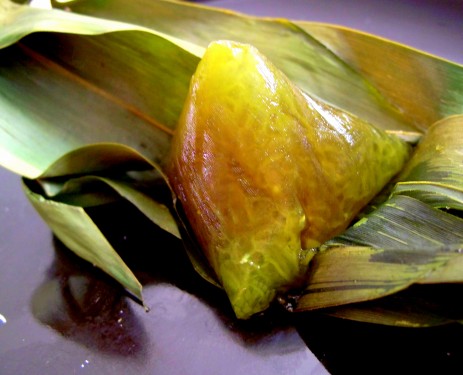 The recipe calls for a lot of prep time (up to a year!), and the products are little triangular pyramids sold for $3.75 a bunch at sandwich shops. But hey, if you can make bánh ú tro, you can enjoy it any time of the year without having to wait until the Fifth of Lunar May. 1. Ash water Use the fine, soft ash from burnt coal, dissolve in water. The common ratio is 50 grams of ash for every liter of water, but it varies depend on how strong the ash is and how strong you want your banh to be. Let the ash collect at the bottom, leaving a clear solution. Sift the solution to get rid of dirt and coal bits. You can use lime powder instead of ash. White lime gives bánh ú tro the natural green hues of wrapping leaves, red lime gives them reddish amber hues. The mixing ratio is 20 grams/liter for lime powder. Continue reading Recipe for Bánh ú tro (Vietnamese-adapted jianshui zong)
 Galveston beach is calm today. In Vung Tau we can see foaming waves hitting the shore from 300 feet away, and the sun-shy ones (like myself) can hide under the shade of sheoaks planted along the beach (*). Galveston is different. A blazon strip of land. When you go to the sea on a holiday weekend, you get what you expect: (too) plenty of sunshine, sand, lots of people smiling, sweating on the bikes, burning tanning on the beach. When you go to a Chinese restaurant, you expect cheap, commonplace food, casual companies and indeed they are. But never expect too much. We went to China Island, a “restaurant” 10 minutes from the sea, expected decent seafood, and didn’t get it. A lady stared at little mom, making her feel guilty for taking the last fish fillet. Later we found out the lady didn’t really miss much, the fish wasn’t fresh. The fried shrimps were poorly coated and poorly fried. Continue reading Beach and buffet
|
|
Blogs we read
|











